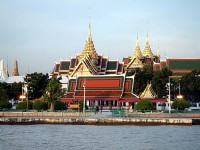The Grand Palace is comprised of intricate details and architectures of Thai, Asian and European style, including the Amarinda Hall, Boromabiman Hall, Dusit Hall, the Grand Palace Hall (Chakri Maha Prasat), the Museum, and Wat Phra Kaew (Temple of the Emerald Buddha). The Amarinda Hall (Throne Hall) was the Hall of Justice and was also the original residence of King Rama I, and now used for royal ceremonial events and coronations. An ancient throne positioned under a nine tired white canopy can be seen in the Amarinda Hall, which was used before the western style throne presently in use. The Boromabiman Hall was where King Rama VI stayed at sometime. The Grand Place Hall and the Dusit Hall are where visitors can find the finest structures among all, and where visitors are allowed inside to see the spacious European style reception room. A number of scale models and Buddha images of the Grand Palace restoration are displayed at the Museum.
Wat Phra Kaew (Temple of the Emerald Buddha) is regarded as the most significant temple of Thailand, and is also one of the must-sees that one should not miss for their Thai travel. There is a distinctive contrast in style between the Grand Palace and Wat Phra Kaew, thou they are in the proximity. Wat Phra Kaew is a very traditional Thai temple, while the Grand Palace is designed in a European inspired style. Wat Phra Kaew contains the greatly revered Emerald Buddha that dates back to the 14th century. The robes on the Buddha are being changed with the seasons by the King of Thailand.
Though, the Grand Palace is no longer the Royal residence, and opened for tourists, it is still very much in use for Royal ceremony purposes such as ceremonial state dinners for foreign dignitaries, royal funerals, marriages, banquets and more. Nowadays, the King lives in the Chitralada Place in Dusit area of Bangkok, which is not far away from the Grand Palace.











































